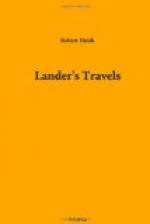The route lay along the banks of the river Yeou, called also Gambarou, through a country naturally fertile and delightful, but presenting a dismal picture of the desolation occasioned by African warfare. The expedition passed through upwards of thirty towns, completely destroyed by the Fellatas in their last inroad, and of which all the inhabitants had been either killed or carried into slavery. These fine plains were now overgrown with forests and thickets, in which grew tamarind and other trees, producing delicate fruits, while large bands of monkeys, called by the Arabs “enchanted men,” filled the woods with their cries. Here, too, was found old Birnie, the ancient but now desolate capital, evidently much larger than any of the present cities, covering five or six miles with its ruins. They passed also Gambarou, formerly the favourite residence of the sultans, where the remains of a palace and two mosques gave an idea of civilization superior to any thing that had yet been seen in interior Africa. There were left in this country only small detached villages, the inhabitants of which remained fixed to them by local attachment, in spite of constant predatory inroads of the Tuaricks, who carried off their friends, their children, and cattle. They have recourse to one mode of defence, which consists in digging a number of blaquas, or large pits; these they cover with a false surface of sods and grass, into which the Tuarick with his horse plunges before he is aware, and is received at the bottom upon sharp-pointed stakes, which often kill both on the spot. Unluckily, harmless travellers are equally liable to fall into these living graves. Major Denham was petrified with horror, to find how near he had approached to several of them; indeed one of his servants stepped upon the deceitful covering, and was saved only by an almost miraculous spring. It seems wonderful that the sheik should not have endeavoured to restore some kind of security to this portion of his subjects, and to re-people those fine but deserted regions.
The troops that had been seen hastening in parties to the scene of action were mustered at Kobshary, a town which the Mungas had nearly destroyed. The sheik made a review of his favourite forces, the Kanemboo spearmen, nine thousand strong. They were really a very savage and military-looking host, entirely naked, except a girdle of goat-skin, with the hair hanging down, and a piece of cloth wrapped round the head. They carried large wooden shields, shaped like a gothic window, with which they warded off the arrows of the enemy, while they pressed forward to attack with their own spears. Unlike almost all other barbarous armies, they kept a regular night-watch, passing the cry every half-hour along the line, and, at any alarm, raising a united yell, which was truly frightful. At the review they passed in tribes before the sheik, to whom they showed the most enthusiastic attachment, kneeling on the ground, and kissing his feet. The Mungas again were described as terrible antagonists, hardened by conflicts with the Tuaricks, fighting on foot with poisoned arrows, longer and more deadly than those of the Fellatas.




